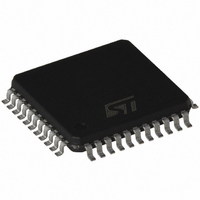ST72F361J9T6 STMicroelectronics, ST72F361J9T6 Datasheet - Page 172

ST72F361J9T6
Manufacturer Part Number
ST72F361J9T6
Description
IC MCU 8BIT 60K FLASH 44-LQFP
Manufacturer
STMicroelectronics
Series
ST7r
Datasheet
1.ST72F361K6T6.pdf
(225 pages)
Specifications of ST72F361J9T6
Core Processor
ST7
Core Size
8-Bit
Speed
8MHz
Connectivity
LINSCI, SPI
Peripherals
LVD, POR, PWM, WDT
Number Of I /o
32
Program Memory Size
60KB (60K x 8)
Program Memory Type
FLASH
Ram Size
2K x 8
Voltage - Supply (vcc/vdd)
3.8 V ~ 5.5 V
Data Converters
A/D 16x10b
Oscillator Type
External
Operating Temperature
-40°C ~ 85°C
Package / Case
44-LQFP
Processor Series
ST72F3x
Core
ST7
Data Bus Width
8 bit
Data Ram Size
2 KB
Interface Type
LINSCI, SPI
Maximum Clock Frequency
8 MHz
Number Of Programmable I/os
34
Number Of Timers
2
Maximum Operating Temperature
+ 85 C
Mounting Style
SMD/SMT
Development Tools By Supplier
ST72F36X-SK/RAIS, STX-RLINK
Minimum Operating Temperature
- 40 C
On-chip Adc
10 bit, 11 Channel
Lead Free Status / RoHS Status
Lead free / RoHS Compliant
Eeprom Size
-
Lead Free Status / Rohs Status
Details
Available stocks
Company
Part Number
Manufacturer
Quantity
Price
Company:
Part Number:
ST72F361J9T6
Manufacturer:
STMicroelectronics
Quantity:
50
Company:
Part Number:
ST72F361J9T6
Manufacturer:
STMicroelectronics
Quantity:
10 000
- Current page: 172 of 225
- Download datasheet (8Mb)
ST72361
11 INSTRUCTION SET
11.1 CPU ADDRESSING MODES
The CPU features 17 different addressing modes
which can be classified in seven main groups:
The CPU Instruction set is designed to minimize
the number of bytes required per instruction: To do
Table 31. CPU Addressing Mode Overview
172/225
Addressing Mode
Inherent
Immediate
Direct
Indexed
Indirect
Relative
Bit operation
Inherent
Immediate
Short
Long
No Offset
Short
Long
Short
Long
Short
Long
Relative
Relative
Bit
Bit
Bit
Bit
Mode
Direct
Direct
Direct
Direct
Direct
Indirect
Indirect
Indirect
Indirect
Direct
Indirect
Direct
Indirect
Direct
Indirect
Indexed
Indexed
Indexed
Indexed
Indexed
Relative
Relative
Example
nop
ld A,#$55
ld A,$55
ld A,($55,X)
ld A,([$55],X)
jrne loop
bset
byte,#5
nop
ld A,#$55
ld A,$10
ld A,$1000
ld A,(X)
ld A,($10,X)
ld A,($1000,X)
ld A,[$10]
ld A,[$10.w]
ld A,([$10],X)
ld A,([$10.w],X)
jrne loop
jrne [$10]
bset $10,#7
bset [$10],#7
btjt $10,#7,skip
btjt [$10],#7,skip
Syntax
Destination
00..FF
0000..FFFF
00..FF
00..1FE
0000..FFFF
00..FF
0000..FFFF
00..1FE
0000..FFFF
PC+/-127
PC+/-127
00..FF
00..FF
00..FF
00..FF
so, most of the addressing modes may be subdi-
vided in two submodes called long and short:
– Long addressing mode is more powerful be-
– Short addressing mode is less powerful because
The ST7 Assembler optimizes the use of long and
short addressing modes.
cause it can use the full 64 Kbyte address space,
however it uses more bytes and more CPU cy-
cles.
it can generally only access page zero (0000h -
00FFh range), but the instruction size is more
compact, and faster. All memory to memory in-
structions use short addressing modes only
(CLR, CPL, NEG, BSET, BRES, BTJT, BTJF,
INC, DEC, RLC, RRC, SLL, SRL, SRA, SWAP)
00..FF
00..FF
00..FF
00..FF
00..FF
00..FF
00..FF
Address
Pointer
(Hex.)
Pointer Size
byte
word
byte
word
byte
byte
byte
(Hex.)
+ 0
+ 1
+ 1
+ 2
+ 0
+ 1
+ 2
+ 2
+ 2
+ 2
+ 2
+ 1
+ 2
+ 1
+ 2
+ 2
+ 3
(Bytes)
Length
Related parts for ST72F361J9T6
Image
Part Number
Description
Manufacturer
Datasheet
Request
R

Part Number:
Description:
STMicroelectronics [RIPPLE-CARRY BINARY COUNTER/DIVIDERS]
Manufacturer:
STMicroelectronics
Datasheet:

Part Number:
Description:
STMicroelectronics [LIQUID-CRYSTAL DISPLAY DRIVERS]
Manufacturer:
STMicroelectronics
Datasheet:

Part Number:
Description:
BOARD EVAL FOR MEMS SENSORS
Manufacturer:
STMicroelectronics
Datasheet:

Part Number:
Description:
NPN TRANSISTOR POWER MODULE
Manufacturer:
STMicroelectronics
Datasheet:

Part Number:
Description:
TURBOSWITCH ULTRA-FAST HIGH VOLTAGE DIODE
Manufacturer:
STMicroelectronics
Datasheet:

Part Number:
Description:
Manufacturer:
STMicroelectronics
Datasheet:

Part Number:
Description:
DIODE / SCR MODULE
Manufacturer:
STMicroelectronics
Datasheet:

Part Number:
Description:
DIODE / SCR MODULE
Manufacturer:
STMicroelectronics
Datasheet:

Part Number:
Description:
Search -----> STE16N100
Manufacturer:
STMicroelectronics
Datasheet:

Part Number:
Description:
Search ---> STE53NA50
Manufacturer:
STMicroelectronics
Datasheet:

Part Number:
Description:
NPN Transistor Power Module
Manufacturer:
STMicroelectronics
Datasheet:

Part Number:
Description:
DIODE / SCR MODULE
Manufacturer:
STMicroelectronics
Datasheet:











